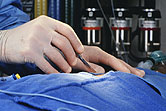- Skip Storing This Everyday Product in the Fridge Door
- Green Tea + B3 Pairing May Boost Brain Health
- Navigating Your Midlife Crisis: Embracing New Possibilities
- City Raccoons Showing Signs of Domestication
- Mapping the Exposome: Science Broadens Focus to Environmental Disease Triggers
- One Week Less on Social Media Linked to Better Mental Health
- Your Brain Changes in Stages as You Age, Study Finds
- Some Suicide Victims Show No Typical Warning Signs, Study Finds
- ByHeart Formula Faces Lawsuits After Babies Sickened With Botulism
- Switch to Vegan Diet Could Cut Your Greenhouse Gas Emissions in Half
Mesh for Hernia Repair Reduces Recurrence, Study Suggests


Using surgical mesh instead of stitches alone when repairing abdominal hernias appears to reduce the chances the problem will return, a new study suggests.
But mesh use is linked to other surgical risks, including infection, the researchers said.
“When repairing primary abdominal hernias, mesh reinforcement has the best long-term outcomes in most situations,” said the study’s lead researcher, Dr. Mike Liang, an assistant professor of surgery at the University of Texas Health Sciences Center at Houston.
An abdominal hernia occurs when the intestines bulge through a weak spot in the abdominal wall. Often, surgeons use a loosely woven sheet of flexible mesh to patch the weakness or plug up the hole instead of simply stitching it.
The advantage of the mesh is it allows the tension created by the repair to be spread across the abdominal wall, which in turn allows the patient to have normal movement after surgery, said Dr. Steven Hodgett, a general surgeon at Baptist Health in Jacksonville, Fla.
According to Hodgett, synthetic plastic mesh adds about $50 to $100 to the procedure’s cost. Biological mesh could add more than $8,000, he said.
In the United States, more than 350,000 abdominal hernia repair surgeries are performed each year, according to background information in the study. Of these, 75 percent are known as primary ventral hernias (weakening of the abdominal walls, usually at the navel).
There have been two repair options, Hodgett said. One involves an open surgery and repairs the hernia with mesh and stitches. The downside of this procedure is that it increases the risk of infection, so it is not recommended for obese patients or others in whom the risk of infection is a primary concern, he said.
The other, less-invasive procedure, uses stitches alone. Because of the smaller incision, the odds of infection are lower, but there is a greater risk of recurrence, Hodgett noted.
“Hernia repair is a complex patient decision, but there are great options. It appears our ability to fix hernias is evolving as we try to bring our recurrence and complication rates down to zero,” Hodgett said.
Dr. Michael Castellano, director of the hernia program at Staten Island University Hospital in New York City, said most surgeons have long believed that using mesh generally reduces recurrence. The study confirms this belief, he said.
“The infection rate in both groups is essentially similar, but the seroma [pockets of clear fluid that develop after surgery] is higher with mesh,” Castellano added. “Fortunately, seromas usually resolve on their own, and rarely need drainage or significant intervention. As techniques improve, I’m sure seroma rates will fall also.”
For the study, published Feb. 19 in the online edition of JAMA Surgery, Liang’s team analyzed the data in nine studies done between 1980 and 2012, comparing the use of mesh versus stitches alone. In total, 637 mesh repairs and 1,145 suture repairs were included.
When mesh was used with stitches, the recurrence rate was just 2.7 percent, compared with 8.2 percent with stitches alone, the results showed.
However, mesh use increased the odds of seromas — 7.7 percent versus 3.8 percent, the researchers found. And incision infections were slightly more common with mesh, 7.3 percent versus 6.6 percent.
The authors suggest that further studies are needed to determine if one surgical technique has clear advantages over the other.
“As with any treatment — medical or surgical — there is nuance and patient-specific factors that should be considered when deciding on a treatment,” said Dr. Robert Andrews, director of acute care surgery at Lenox Hill Hospital in New York City.
Obesity, the mesh material used, tobacco use, technical factors related to the operation, and certain medications may affect the results, Andrews pointed out.
“I believe a safe message for patients is unchanged: Consult with an experienced surgeon and discuss your particular case,” Andrews said.
More information
For more information on hernia, visit the U.S. National Library of Medicine.
Source: HealthDay
Copyright © 2025 HealthDay. All rights reserved.










